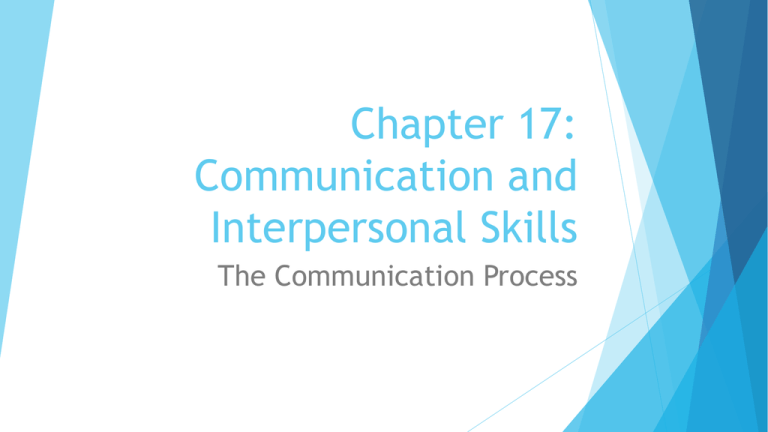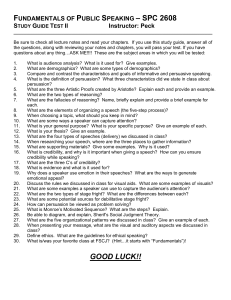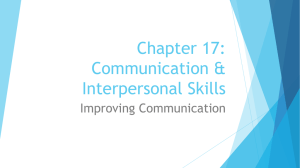Chapter 17: Communication and Interpersonal Skills
advertisement

Chapter 17: Communication and Interpersonal Skills The Communication Process The Communication Process Communication. An interpersonal process of sending and receiving symbols with messages attached to them. Key elements of the communication process: Sender. Message. Communication channel. Receiver. Interpreted meaning. Feedback. Management Fundamentals - Chapter 17 2 Figure 17.1 The interactive two-way process of interpersonal communication. Management Fundamentals - Chapter 17 3 The Communication Process Effective and efficient communication: Effective communication Occurs when the intended meaning of the sender is identical to the interpreted meaning of the receiver. Efficient communication Occurs at a minimum resource cost (Ex. Email rather then one-on-one meeting). Potential trade-offs between effectiveness and 4 efficiency must be recognized. Management Fundamentals - Chapter 17 Vaughn Mills Trip – Manager Meetings Trip Date: January 7th, 2016 For details on your assignment & expectations pre & post interviews, go to link: www.msboseovski-businessleadership.weebly.com Click on Vaughn Mills Trip link. Read course assignment for details Efficient or Effective Communication? What are the trade-offs? The Communication Process Persuasion and credibility in communication. Communication is used for sharing information and influencing other people. Persuasion is getting someone else to support the message being presented. Managers get things done by convincing rather than order giving. Management Fundamentals - Chapter 17 7 The Communication Process Persuasion and credibility in communication (cont.). Expert power and referent power are essential for persuasion. Credibility involves trust, respect, and integrity in the eyes of others. Credibility can be built through expertise and relationships. Management Fundamentals - Chapter 17 8 The Communication Process Sources of noise in communication: Poor choice of channels. Poor written or oral expression. Failure to recognize nonverbal signals. Physical Status distractions. effects. Management Fundamentals - Chapter 17 9 The Communication Process Poor choice of channels. Choose the channel that works best. Written channels work for messages that: Are simple and easy to convey. Require extensive dissemination (spreading) quickly. Convey formal policy or authoritative directives. Spoken channels work best for messages that: Are complex or difficult to convey where immediate feedback is needed. Attempt to create a supportive, even inspirational, climate. Management Fundamentals - Chapter 17 10 What communication channel works better? Written vs. Spoken? Daily Homework Assignments Mathematical Theories Code of Conduct & Classroom Rules Assigned selling locations for week of Pearson Student Market The Communication Process Failure to recognize nonverbal signals. Nonverbal communication takes place through gestures, facial expressions, body posture, eye contact, and use of interpersonal space. Mixed messages occur when a person’s words and nonverbal signals communicate different things. The growing use of communication technologies causes important nonverbal communication to be lost. Management Fundamentals - Chapter 17 12 Read below: The Pearson Formal Committee has spent hours planning and organizing all the décor and fine details to ensure the event meets and exceed student expectations. They have recently settled on the décor theme and special keepsake gift that students will treasure for years to come. The Communication Process Physical distractions. Include interruptions from telephone calls, drop-in visitors, a lack of privacy, etc. Can interfere with the effectiveness of a communication attempt. Can be avoided or at least minimized through proper planning. Management Fundamentals - Chapter 17 14 The Communication Process Status effects. Occur when an organization’s hierarchy of authority creates a barrier to effective communication. Status effects include: Filtering — the intentional distortion of information to make it appear favorable to the recipient. Subordinates acting as “yes men.” Management Fundamentals - Chapter 17 15 Do you think I am an effective teacher?






